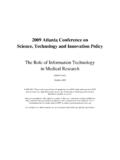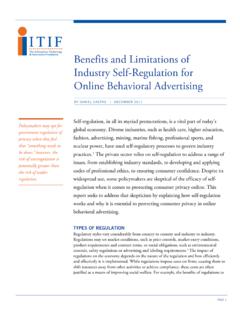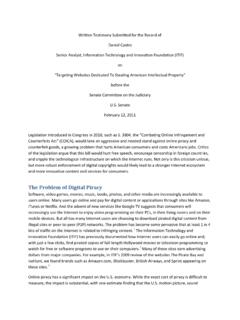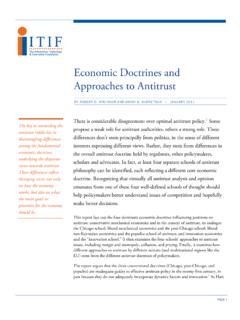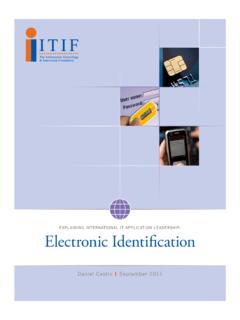Transcription of Embracing the Self-Service Economy - ITIF
1 Embracing theSelf-ServiceEconomyDANIEL CASTRO | ROBERT ATKINSON | STEPHEN EZELLAPRIL 2010 The information technology & Innovation FoundationITIFA pril 2010 Embracing the Self-Service EconomyDaniel CastroRobert AtkinsonStephen EzellT H E I N F O R M A T I O N T E C H N O L O G Y & I N N O V A T I O N F O U N D A T I O NTHE information TECHNOLO GY & INNOVATION FOUNDATION | APRIL 2010 T H E I N F O R M A T I O N T E C H N O L O G Y & I N N O V A T I O N F O U N D A T I O NTable of ContentsI. Executive Summary ..1II. Introduction ..3 A. What is self service? ..4 III. Benefits of self service ..4 A. Benefits for consumers ..4 B. Benefits for businesses ..5 C. Benefits for the Economy .
2 6IV. Types of Self-Service technology ..7 A. Electronic kiosks ..7 1. Banking ..7 2. Self-Service gasoline stations ..8 3. self -pay parking, tolls, and transit ..9 4. Food-ordering kiosks ..9 5. Airport and travel kiosks ..10 6. Vending machines and reverse vending machines ..11 7. self checkout ..12 8. Retail kiosks ..13 9. Human resources kiosks ..15 10. Digital photograph printing ..15 11. Postal kiosks ..16 12. Electronic 13. Health care kiosks ..17 14. information kiosks ..17 B. Internet Applications ..18 PAGE IT H E I N F O R M A T I O N T E C H N O L O G Y & I N N O V A T I O N F O U N D A T I O NTHE information TECHNOLO GY & INNOVATION FOUNDATION | APRIL 2010 T H E I N F O R M A T I O N T E C H N O L O G Y & I N N O V A T I O N F O U N D A T I O N 1.
3 Online health ..18 2. Online banking ..18 3. 4. Professional services ..19 5. Retail e-commerce ..20 6. Customer service ..21 7. Online customization ..22 8. Access to government 9. Ticketing and reservations ..23 C. Mobile devices, including smart phones and smart cards ..24 1. Smart phones ..24 2. Mobile payments ..25 3. Smart cards ..27 4. Mobile Self-Service in the developing world ..28 D. Phone Applications ..29V. Impact of labor cost on Self-Service technology adoption ..30VI. Responding to concerns over Self-Service .
4 31 A. Concern: Self-Service simply shifts work to the B. Concern: self service eliminates consumer choice and robs individuals of human contact ..31 C. Concern: self service destroys jobs ..32 D. Concern: Even if Self-Service boosts productivity, workers will not benefit ..34 VII. Policy Recommendations ..34 A. Resist and overturn policies that restrict business use of Self-Service technologies ..34 B. Support prosumer technologies like broadband, electronic IDs and mobile payment systems.
5 36 C. Encourage greater government use of Self-Service technology ..37 PAGE IIT H E I N F O R M A T I O N T E C H N O L O G Y & I N N O V A T I O N F O U N D A T I O NTHE information TECHNOLO GY & INNOVATION FOUNDATION | APRIL 2010 T H E I N F O R M A T I O N T E C H N O L O G Y & I N N O V A T I O N F O U N D A T I O N D. Support creation of a Center of Excellence for Accessible Design in IT-enabled self Service ..37 E. Increase the minimum wage in order to boost Self-Service technology adoption ..37 F. Provide stronger safety nets for workers adversely affected by technological change ..38 VIII. Conclusion ..38 PAGE IIIT H E I N F O R M A T I O N T E C H N O L O G Y & I N N O V A T I O N F O U N D A T I O NTHE information TECHNOLO GY & INNOVATION FOUNDATION | APRIL 2010 T H E I N F O R M A T I O N T E C H N O L O G Y & I N N O V A T I O N F O U N D A T I O N Figure 1: Estimated average bank transaction costs, by technology .
6 6 Figure 2: ATM Deployment in the United States, 1994-2008 ..8 Figure 3: self -boarding gate at the Paris-Charles de Gaulle Airport ..10 Figure 4: eCycling Station from ecoATM ..11 Figure 5: self -checkout terminals deployed by region, 2008..13 Figure 6: Cost of HR application, Self-Service vs. manual ..16 Figure 7: E-commerce retail sales as a percent of total sales, 2000-2009 ..20 Figure 8: Anna, the IKEA online assistant ..21 Figure 9: Implementation of e-ticketing for air travel worldwide, 2006-2009 ..24 Figure 10: Electronic boarding pass on an iPhone..25 Figure 11: Mobile NFC Payment at a Japan Railway Station ..26 Table 1: Deployment of Contactless Fare Payment in Mass Transit..27 PAGE IVList of Figures and TablesT H E I N F O R M A T I O N T E C H N O L O G Y & I N N O V A T I O N F O U N D A T I O NT he past decade has witnessed a rapid growth in self service that allows consumers to take on the traditional role of a service worker in the provision of a service.
7 self service has long existed think of placing a call by dialing a telephone instead of using a telephone operator or pressing a button in an elevator instead of using an elevator operator but its importance has grown as ad-vances in information technology (IT) have created many opportu-nities to leverage Self-Service technology for large gains in efficiency and convenience. Using computer kiosks, airline travelers check in to their flights; on the Internet, consumers purchase products without ever speaking to a sales agent; and, using a mobile phone, customers check their bank balances and transfer funds. Self-Service technology continues to become more efficient and more convenient, and, as a re-sult, increasingly organizations, including businesses, non-profits and governments, are using Self-Service technology to operate more pro-ductively and to better serve their technology has already transformed entire industries, from ATMs in banking to e-commerce in the travel industry, resulting in significant savings for businesses which are passed on to consumers in the form of lower prices and better service.
8 However, even though Self-Service technology has generated a wide range of benefits and savings for consumers, businesses, and government, it is only the beginning. Over at least the next decade, self -ser-vice technology has the potential to be We estimate that if Self-Service technolog y were more widely deployed, the Economy would be approximately $130 billion larger annually, the equivalent of an additional $1,100 in annual income for every Summarya major force for growth in productivity and improvements in quality of life. We estimate that if Self-Service technology were more widely deployed, the Economy would be approximately $130 billion larger annually, the equivalent of an additional $1,100 in annual income for every savings could not be coming at a more crucial time.
9 Most national econo-mies will need the power of Self-Service technologies if they are to avoid serious THE information TECHNOLO GY & INNOVATION FOUNDATION | APRIL 2010 PAGE 2economic problems stemming from significant growth in the number of retirees, a situation that will be par-ticularly acute in Europe, Japan, and the United States. In the United States, for example, the number of retir-ees for every 1,000 working age adults is projected to grow from 213 today to 346 by 2030. For Social Secu-rity recipients in 2030 to not see a decline in their in-flation-adjusted payments without workers seeing a de-cline in their after-tax incomes, economic productivity will have to increase by 62 percent. Unfortunately, the Social Security Administration estimates productivity will grow just 40 percent.
10 As a result, in 2030, either worker incomes after Social Security taxes are deducted will be significantly lower, or Social Security benefits will be lower, or both. Self-Service technologies prom-ise to be a major source of needed productivity growth, enabling the United States, Japan, Europe, and other nations facing demographic challenges to realize such growth without reductions in wages or these benefits will not automatically occur unless the right policies are in place and the wrong ones are avoided. First, governments should avoid putting in place restrictions on Self-Service business models and processes. This means that policymakers must resist the efforts of special interest groups that press for re-strictions in technology to protect their economic or social interests at the expense of the average citizen.
